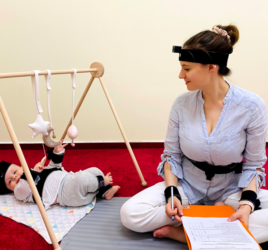
The rocky road of human development
Most handbooks of developmental psychology describe human development in terms of a sequence of stages or gradual increase in capacities across ages. However, when we follow the development of individual children, we observe some global order, but also a lot of irregularity. For instance, when learning to speak, most children start with using single word expressions, followed by short combined multi-word utterances, after which a syntactic stage sets in (where sentences are formed according to rules). In contrast, when looking at the language of individual children from day to day, we see sudden improvements, but also many sudden fallbacks and regressions. Development is not linear or global; it is a ‘rocky road’. This is what we call intra-individual variability: differences in behavior within individuals at different moments in time [1].
Development is not linear or global; it is a ‘rocky road’.
Though this type of variability is a universal finding, its importance is not always recognized. One reason for this is that it is often conceived as being merely a reactive phenomenon. The moment-to-moment irregularities are seen as the result of reactions to context changes or even measurement error, which are considered to be independent of ‘real’ development. The methodological solution is rather straightforward: averaging over the irregularities. This approach is very popular and is still used in the majority of developmental studies.
An alternative viewpoint on variability
Already more than two decades ago, with the rise of complex dynamic systems-theorizing in psychology, an alternative viewpoint on intra-individual variability was offered. This viewpoint holds that intra-individual variability is a genuine property of development [2, 3]. This approach defines development as a self-organizing system of components that constantly interact with each other and the context. The child is not a passive recipient of varying contexts, but an active participant who creates his own variability. In this way, variability is a driving force of development. In a dynamic system, structural reorganizations (such as with the acquisition of certain syntactical rules) occur at transition points, periods of instability where old patterns break down and new ones emerge. During these transition points, patterns of variability change. Its presence can therefore be used to detect these transition points [4].
In the early 1990s already, the founding ‘fathers and mothers’ of the complex dynamic systems approach urged developmental psychologists to treat intra-individual variability as data and to use it in their analyses, instead of getting rid of it by means of averaging techniques. From that moment on, a steadily increasing group of researchers have acted accordingly, and now we can review the results of a variety of topics in human development such as motor coordination (e.g. reaching and grasping), cognitive (e.g. reasoning, reading) and language development (e.g. sentence length), and emotional/social development (e.g. parent-child interaction).
Characterizing variability
From these studies, the first thing we have learned is that the amount of variability is not the same across all time points in all areas of development. In some cases, a general decrease of variability is observed, for instance in the mother-child interaction during feeding in infancy. In other cases, children display an increase of variability with age, as is the case in, for instance, cognitive development. Yet other cases show peak variability: an increase in variability followed by a decrease. We see examples in language development, where the acquisition of a new grammatical rule is often accompanied by a period of irregular usage of this rule. Several authors have proposed the more integrated view that these changes in variability should be seen as the result of a cyclical process where periods with low variability alternate with periods of high variability [5]. In some cases a lack of variability can be a sign of developmental problems, for instance in excessive crying in infancy, food refusal, and coercive cycles in parenting. In other cases a lack of stability is an indicator of problems, like for early motor coordination problems, and dyslexia.
Not only the amount of variability, but also the structure of variability is important. Tools from the field of nonlinear dynamics have demonstrated that certain patterns are more optimal for development than others. To be more specific, a particular variability pattern called ‘pink noise’ (or ‘fractal noise’) indicates a complex nested pattern across time scales, which probably serves a coordinative function [6]. Pink noise can also be observed in physical systems (e.g. meteorological data, radiation) and biological systems (e.g. heart beat rhythms). In contrast, a truly random pattern (‘white noise’) is related to lower levels of performance and coordination. This is the case for reading, as dyslexic readers showed more random (less fractal) patterns of reading fluency than non-dyslexic readers [7]).
Change and variability are intrinsically related, which makes the study of variability indispensable across psychology and beyond.
The findings from developmental psychology are relevant for many other branches of psychology that are – in a sense – all interested in change. Just as the neuropsychologist studies the microscopic changes at the brain level, the social psychologist is interested in the attitude and behavioral changes across contexts, and the experimental psychologist often induces change in the course of an experiment. Change and variability are intrinsically related, which makes the study of variability indispensable across psychology and beyond.
Relevant Links and Publications
Note: Image by Marijn van Dijk



